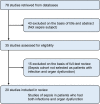Epidemiology of sepsis in a Japanese administrative database
- PMID: 37841963
- PMCID: PMC10570497
- DOI: 10.1002/ams2.890
Epidemiology of sepsis in a Japanese administrative database
Abstract
Sepsis is the leading cause of death worldwide. Considering regional variations in the characteristics of patients with sepsis, a better understanding of the epidemiology in Japan will lead to further development of strategies for the prevention and treatment of sepsis. To investigate the epidemiology of sepsis, we conducted a systematic literature review of PubMed between 2003 and January 2023. Among the 78 studies using a Japanese administrative database, we included 20 that defined patients with sepsis as those with an infection and organ dysfunction. The mortality rate in patients with sepsis has decreased since 2010, reaching 18% in 2017. However, the proportion of inpatients with sepsis is increasing. A study comparing short-course (≤7 days) and long-course (≥8 days) antibiotic administration showed lower 28-day mortality in the short-course group. Six studies on the treatment of patients with septic shock reported that low-dose corticosteroids or polymyxin B hemoperfusion reduced mortality, whereas intravenous immunoglobulins had no such effect. Four studies investigating the effects of treatment in patients with sepsis-associated disseminated intravascular coagulation demonstrated that antithrombin may reduce mortality, whereas recombinant human soluble thrombomodulin does not. A descriptive study of medical costs for patients with sepsis showed that the effective cost per survivor decreased over an 8-year period from 2010 to 2017. Sepsis has a significant impact on public health, and is attracting attention as an ongoing issue. Further research to determine more appropriate prevention methods and treatment for sepsis should be a matter of priority.
Keywords: Diagnosis Procedure Combination; Sepsis‐3; administrative database; claim database; organ dysfunction.
© 2023 The Authors. Acute Medicine & Surgery published by John Wiley & Sons Australia, Ltd on behalf of Japanese Association for Acute Medicine.
Conflict of interest statement
The authors declare no conflicts of interest.
Figures
References
-
- Torio CM, Moore BJ. National inpatient hospital costs: the most expensive conditions by payer, 2013: statistical brief #204. Healthcare cost and utilization project (HCUP) statistical briefs. Rockville, MD: Agency for Healthcare Research and Quality (US); 2006. - PubMed
-
- Shankar‐Hari M, Harrison DA, Rubenfeld GD, Rowan K. Epidemiology of sepsis and septic shock in critical care units: comparison between sepsis‐2 and sepsis‐3 populations using a national critical care database. Br J Anaesth. 2017;119(4):626–636. - PubMed
Publication types
LinkOut - more resources
Full Text Sources


